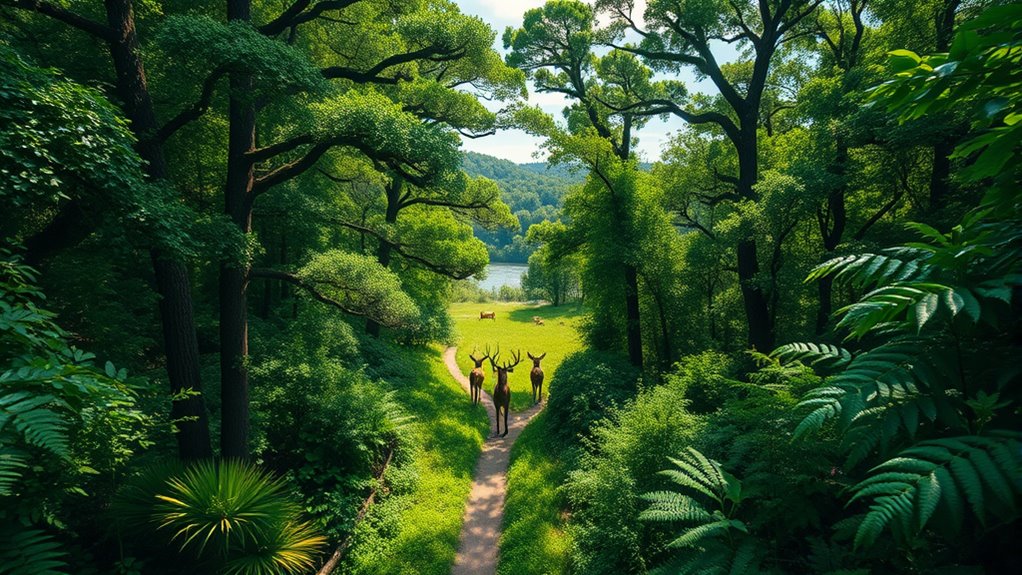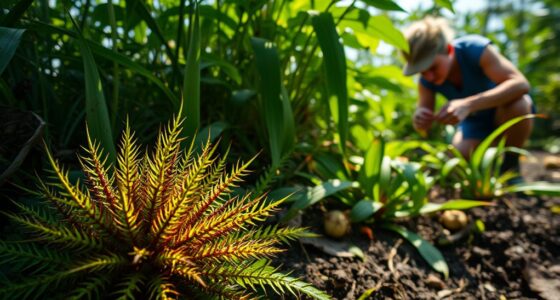Wildlife corridors are essential pathways that connect fragmented habitats, allowing animals to safely navigate between ecosystems. These corridors promote genetic diversity and support biodiversity by facilitating migration and colonization. They come in various types, such as regional, sub-regional, and local corridors, each with unique ecological benefits. However, implementing these corridors can face challenges, including community resistance and land use conflicts. Discover how successful examples and conservation strategies can enhance wildlife corridors and protect ecosystems further.
Key Takeaways
- Wildlife corridors connect fragmented landscapes, enabling safe animal navigation and promoting genetic diversity among isolated populations.
- Types of corridors include regional, sub-regional, local, and stepping stone corridors, each serving different ecological needs.
- Successful examples, like the Yellowstone to Yukon initiative, demonstrate the effectiveness of corridors in facilitating wildlife movement.
- Challenges in corridor implementation include social resistance, economic constraints, and land use conflicts, requiring community engagement and communication.
- Conservation strategies emphasize habitat reconnection, genetic diversity, and collaboration with stakeholders to enhance ecosystem resilience and support wildlife populations.
Definition and Purpose of Wildlife Corridors

Wildlife corridors serve as vital lifelines for animals navigating fragmented landscapes. These connections enable isolated populations to interact, promoting genetic diversity and population stability.
As human activities like development and road construction fragment natural habitats, corridors become essential to mitigate these impacts. They allow animals to migrate safely, colonize new areas, and maintain biodiversity, reducing the risk of extinction. Wildlife corridors are designed to facilitate movement without human-induced barriers, enhancing their effectiveness in connecting habitats. The establishment of these corridors can also reflect the principles of environmental innovations, which aim to improve sustainability and resource efficiency. Ensuring the survival of various species depends on emergency preparedness essentials, which focus on creating safe environments for wildlife. Additionally, corridors can play a critical role in preserving biodiversity hotspots that are at risk from human activities.
By facilitating daily and seasonal movements, corridors support ecosystem health and resilience. They also aid in crucial processes like seed and pollen dispersal, enhancing plant diversity.
Ultimately, wildlife corridors help ensure that species can adapt to changing environments, making them a key tool for conservationists and ecologists dedicated to protecting our planet’s wildlife.
Types of Wildlife Corridors
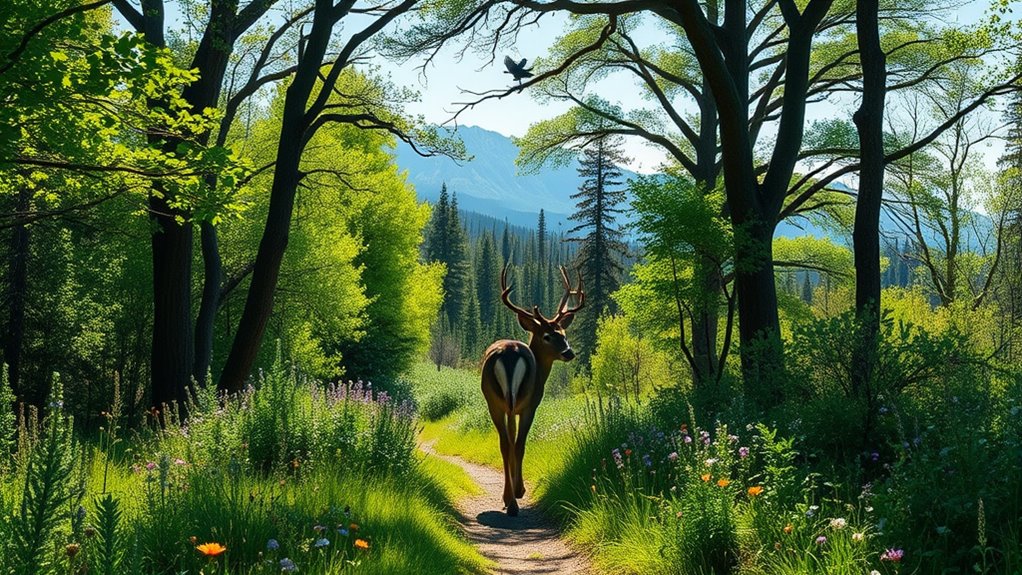
As landscapes become increasingly fragmented, understanding the various types of wildlife corridors is essential for effective conservation.
You’ll find regional wildlife corridors, which span over 500 meters, connecting large habitats and allowing species like migratory birds to traverse significant distances. These corridors are crucial for species survival as they provide necessary space for migration and reproduction. Additionally, these corridors can help mitigate the impacts of climate change on wildlife by allowing species to move to more suitable habitats. The significance of long-term financial planning for conservation efforts cannot be underestimated, as it ensures sustained funding for maintaining these vital corridors. Furthermore, maintaining these corridors can also support metabolic rate improvements in wildlife by providing them with safer pathways to access food sources and breeding grounds.
Sub-regional corridors, ranging from 300 to 500 meters, link smaller ecosystems, supporting local species like foxes and deer.
Local corridors, often less than 50 meters wide, integrate into urban areas and are vital for smaller creatures like pollinators.
Lastly, stepping stone corridors consist of separate habitat patches, aiding species that travel shorter distances but face challenges due to fragmentation.
Each corridor type plays a unique role in maintaining biodiversity and connectivity among habitats.
Ecological Benefits of Corridors
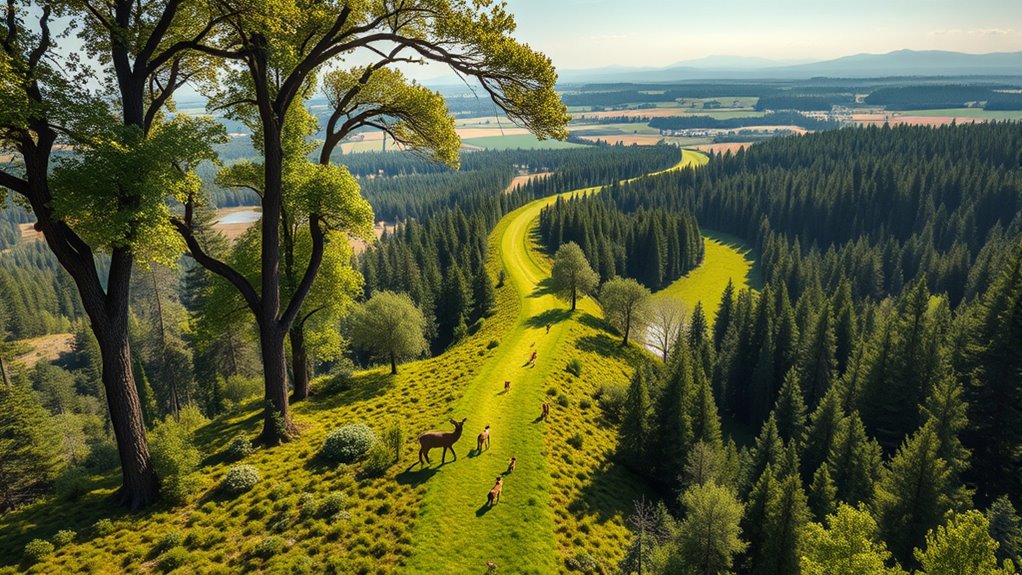
Corridors play a crucial role in enhancing ecological benefits by facilitating the movement of species across fragmented landscapes. They provide essential access to food and water, supporting seasonal migrations and survival. By connecting isolated populations, corridors boost genetic diversity, which helps reduce inbreeding and increases species resilience. These pathways also enhance ecosystem services like pollination and pest control, benefiting both wildlife and agriculture. Additionally, corridors mitigate habitat fragmentation, improving survival rates through better food availability and reduced predation. They allow species to adapt to climate change by moving to more suitable habitats. Furthermore, wildlife crossings such as bridges and tunnels aid in the safe passage of animals over roads and railways, further enhancing connectivity. Incorporating natural materials into corridor designs can also help restore native habitats and support local ecosystems. Multi-tools are also important in wildlife management, as they provide essential tools for monitoring and maintaining these corridors effectively. Moreover, effective management of wildlife corridors requires an understanding of genetic diversity, which is critical for ensuring the long-term resilience of species populations.
Successful Examples of Wildlife Corridors

Connecting fragmented habitats through successful wildlife corridors demonstrates the tangible impact these pathways have on conserving biodiversity.
Wildlife corridors play a crucial role in conserving biodiversity by connecting fragmented habitats and facilitating species movement.
For instance, the Yellowstone to Yukon Conservation Initiative spans 2,000 miles, facilitating wildlife movement along the Rocky Mountains. Similarly, the Jim Prentice Wildlife Corridor links essential forest reserves and national parks to maintain genetic diversity among species, which is crucial for overall population health. In addition, the preservation of these corridors can enhance energy efficiency through the integration of sustainable construction practices that benefit both wildlife and the environment. Moreover, sustainable living practices can help communities understand the importance of preserving these vital corridors.
In urban settings, the Burnham Wildlife Corridor in Chicago supports migratory birds and local wildlife, enhancing urban ecosystems. California’s wildlife overpass over U.S. 101 allows mountain lions to cross safely, while the Lower Rio Grande Valley National Wildlife Refuge restores habitats for rare species like the ocelot. Moreover, the Yellowstone to Yukon Wildlife Corridor connects and protects core habitats, allowing safe passage for various wild species.
These examples highlight how effective corridors can significantly benefit wildlife and promote ecological resilience.
Challenges and Conflicts in Corridor Implementation

While creating wildlife corridors offers significant conservation benefits, several challenges and conflicts can arise during implementation.
You’ll encounter social resistance, as community acceptance is vital; engaging with locals helps address potential conflicts. Moreover, fostering cultural intelligence is essential in understanding community dynamics and building trust among stakeholders. Individuals facing conflict may also experience feelings of emotional manipulation similar to those found in narcissistic relationships, which can hinder collaboration. Furthermore, establishing clear communication and cooperative plans can help mitigate misunderstandings and foster a collaborative environment.
Political barriers may also hinder progress, requiring coordination among varying policies across jurisdictions.
Economic constraints can make purchasing and managing land for corridors expensive.
Moreover, land use conflicts between conservation goals and agricultural or urban development need careful balancing.
Lastly, institutional complexity demands collaboration among multiple stakeholders. Additionally, poorly designed corridors may exacerbate human-wildlife conflicts, while invasive species could spread, threatening native biodiversity. Effective connectivity conservation requires successful interventions across entire corridors to address these challenges.
Addressing these challenges is crucial for successful corridor implementation and ensuring wildlife connectivity.
Conservation Strategies and Future Directions
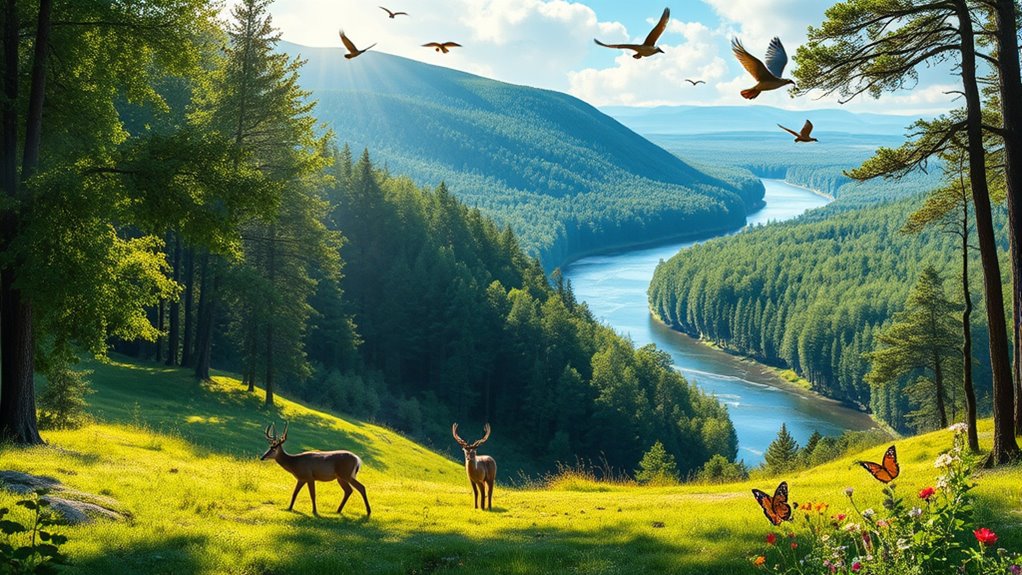
As wildlife corridors play a crucial role in conservation, implementing effective strategies is essential for their success and sustainability. You can start by focusing on habitat reconnection, boosting genetic diversity, and maintaining ecological integrity. Collaborate with stakeholders to ensure land use planning considers both structural and functional connectivity. Essential oils can enhance the wellbeing of local communities involved in conservation efforts. High cultural intelligence (CQ) among team members can further improve collaboration and communication, leading to more effective conservation outcomes.
One key aspect of this planning is to recognize the importance of wildlife movement to ensure that corridors effectively facilitate the migration and dispersal of various species. Understanding the narcissist-borderline dynamic can provide insights into how human interactions may affect wildlife protection efforts.
Optimize corridor designs to minimize human disturbance while providing safe passage for wildlife. Legislative support, like the Wildlife Corridors Conservation Act, can help promote these efforts on a national scale. Looking ahead, integrating corridors into climate change policies and leveraging technology for monitoring will enhance their effectiveness. Engaging local communities ensures ongoing support and awareness, making these strategies vital for the future of wildlife corridors and the ecosystems they serve.
Frequently Asked Questions
How Can Local Communities Get Involved in Wildlife Corridor Projects?
You can get involved in wildlife corridor projects by participating in local workshops and informational sessions.
Share your insights about local wildlife challenges and help shape decision-making processes.
Join or form community groups that advocate for conservation and represent your interests.
Consider engaging in training programs to build your capacity in conservation practices.
What Species Benefit Most From Wildlife Corridors?
Did you know that over 80% of the world’s biodiversity relies on connected habitats?
When it comes to species benefiting from wildlife corridors, large mammals like deer and bears thrive, enabling them to migrate safely.
Predators such as wolves and big cats utilize these paths for territory expansion.
Even small creatures, like amphibians and pollinators, find essential resources in these corridors.
Ultimately, these connections support diverse ecosystems and maintain ecological balance.
How Are Wildlife Corridors Funded and Maintained?
Wildlife corridors get funded through various sources, including public-private partnerships and federal programs that provide grants. Companies and non-profits also contribute to conservation efforts.
To maintain these corridors, habitat restoration is essential, along with installing wildlife-friendly structures. You’ll find that ongoing research and community engagement play critical roles in ensuring effectiveness.
Legal protections help safeguard corridors against encroachment, addressing challenges like human-wildlife conflicts and ecosystem fragmentation.
Are There Legal Protections for Wildlife Corridors?
Imagine a vibrant tapestry of ecosystems, each thread woven together by legal protections.
Yes, there’re legal frameworks safeguarding wildlife corridors. Federal acts like the Wildlife Corridors Conservation Act and the Tribal Wildlife Corridors Act pave the way for enhanced habitat connectivity.
States also join the effort, enacting laws that ensure these vital pathways remain intact.
How Do Wildlife Corridors Impact Human Activities and Land Use?
Wildlife corridors impact your activities and land use by requiring careful planning and coordination among landowners.
As urban development expands, you may find that certain areas become off-limits for new infrastructure to prevent habitat fragmentation.
If you’re involved in development projects, you’ll need to balance human needs with wildlife conservation.
Properly designed corridors can reduce human-wildlife conflicts, making it easier for you to coexist with local species while maintaining your land’s usability.
Conclusion
In the world of conservation, remember that “a chain is only as strong as its weakest link.” Wildlife corridors are vital for connecting habitats, allowing species to thrive and adapt in an ever-changing environment. By recognizing their importance and addressing the challenges in implementing these corridors, you can contribute to a healthier ecosystem. Together, let’s ensure that wildlife can roam freely and safely, bridging the gaps between habitats for a sustainable future.
